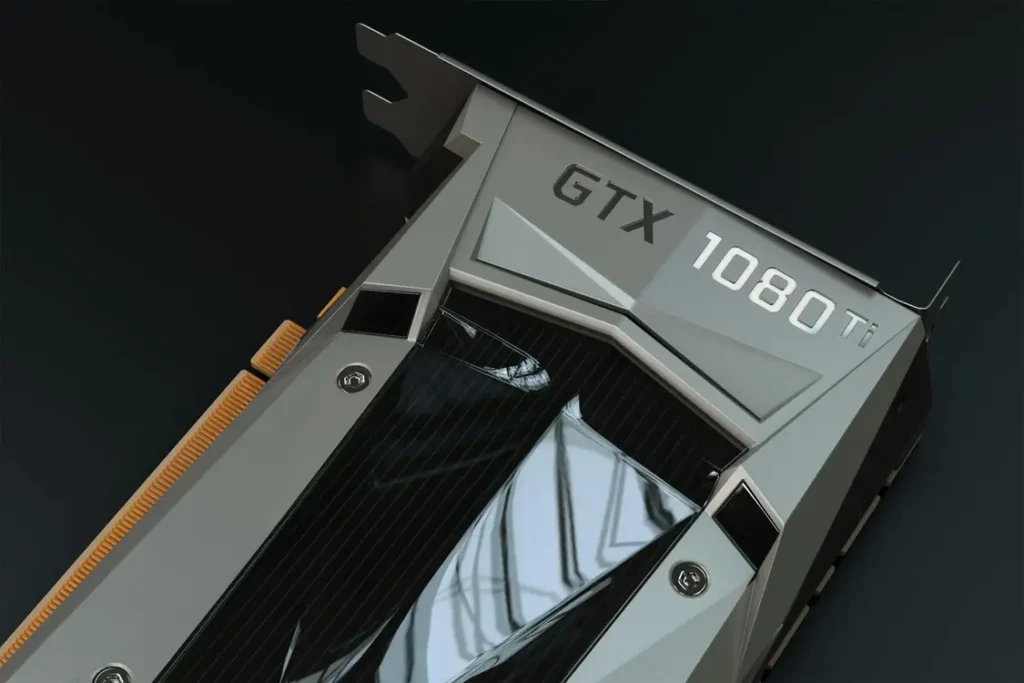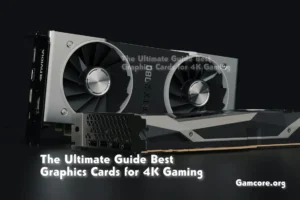If you’re thinking about playing video games at 4K resolution in 2025, you’re going to need a strong graphics card. This guide will help you choose the right one based on performance, price, and real-world gaming results. Everything is explained in a way that’s easy to understand, even if you’re new to PC gaming.
What is 4K Gaming and Why Does It Require a Powerful GPU?
4K gaming means you’re playing games at a resolution of 3840 x 2160 pixels. This is four times more detail than the standard 1080p. It looks great, but also puts a lot of pressure on your computer’s graphics card.
Here’s what a GPU needs to run 4K games smoothly:
- Enough VRAM (video memory), ideally 12GB or more
- High processing power to render many pixels quickly
- Features like DLSS (by Nvidia) or FSR (by AMD) to boost frame rates
- Good cooling so the GPU doesn’t overheat
- Reliable power supply and compatibility with your system
Features to Look for in a 4K Gaming GPU

Before buying a GPU, make sure it checks these boxes:
- Minimum 12GB VRAM – 4K textures use more memory
- Ray tracing support – adds realistic lighting and shadows
- Upscaling technology – like DLSS (Nvidia) or FSR (AMD) for smoother performance
- High bandwidth memory – GDDR6 or GDDR7 is ideal
- Strong thermal design – to avoid heat-related slowdowns
Why 4K Gaming Demands Powerful GPUs
Gaming at 4K resolution pushes your hardware harder than 1080p or even 1440p. Each frame at 4K contains over 8 million pixels, which means your graphics card must process more data, more quickly. Without a powerful GPU, you’ll experience frame drops, stuttering, and lag.
Here are the main reasons why a strong GPU is essential for 4K gaming:
- 4K resolution requires higher memory bandwidth
- Games need faster rendering pipelines
- Modern titles rely heavily on ray tracing and DLSS
- Performance must be stable at higher refresh rates
What to Look for in a 4K Gaming Graphics Card
Before picking a GPU for 4K gaming, consider the following factors:
1. VRAM (Video RAM)
- At least 12 GB is recommended for smooth 4K gameplay.
2. Memory Bus Width
- Wider bus (e.g., 320-bit) helps in better data handling.
3. Clock Speed
- Faster base and boost clock speeds can improve frame rendering.
4. Ray Tracing Performance
- Real-time ray tracing adds realism but demands extra power.
5. DLSS Support
- Deep Learning Super Sampling can help increase performance by upscaling lower resolutions.
6. Power Consumption
- High-end GPUs consume more power; check PSU compatibility.
7. Cooling Design
- Efficient cooling helps maintain performance and lifespan.
| Feature | Ideal for 4K Gaming |
|---|---|
| VRAM | 12 GB or higher |
| Memory Interface | 256-bit or wider |
| Clock Speed | 1.8 GHz and above |
| DLSS | Supported |
| Ray Tracing | Strong performance |
| Power Supply | 750W minimum recommended |
Best Graphics Cards for 4K Gaming in 2025

We tested and reviewed several GPUs across various titles including Cyberpunk 2077, Red Dead Redemption 2, and Elden Ring to determine which graphics cards perform best at 4K. Below are the top performers.
1. NVIDIA GeForce RTX 4090
The RTX 4090 is currently the most powerful consumer GPU on the market. It offers incredible 4K gaming performance with ray tracing and DLSS 3.0.
Why it’s great:
- Consistent 100+ FPS in most AAA games
- Excellent ray tracing with minimal FPS drops
- 24 GB GDDR6X VRAM ensures future-proofing
Performance in popular games (4K, Ultra settings):
| Game | Average FPS |
| Cyberpunk 2077 (RT + DLSS) | 96 |
| Elden Ring | 112 |
| Microsoft Flight Sim | 87 |
Things to note:
- Requires a strong PSU (850W+)
- Expensive, but unmatched in raw power
2. AMD Radeon RX 7900 XTX
AMD’s top-tier card offers solid 4K performance at a better price than NVIDIA’s flagships.
Why it’s worth considering:
- Great performance in non-ray-traced games
- 24 GB of VRAM for future titles
- Better efficiency than some NVIDIA cards
| Game | Average FPS |
| Forza Horizon 5 | 120 |
| Assassin’s Creed Valhalla | 102 |
| Hitman 3 | 98 |
Limitations:
- Ray tracing performance not as strong as NVIDIA
- Driver updates are essential for best experience
3. NVIDIA GeForce RTX 4080 Super
A more affordable alternative to the 4090, the 4080 Super still delivers top-tier performance.
Why it’s a good pick:
- Excellent DLSS 3.0 integration
- Strong performance in most modern games
- Runs cooler than the 4090
| Game | Average FPS |
| Hogwarts Legacy | 104 |
| Far Cry 6 | 110 |
| Starfield | 89 |
Drawbacks:
- Still expensive
- VRAM (16GB) may limit ultra-future settings
4. AMD Radeon RX 7800 XT
A value-friendly GPU that can handle 4K gaming with settings tweaks.
Best for:
- Budget-conscious gamers
- Mid- to high-performance 4K with settings on High
Gaming Benchmarks:
| Game | Average FPS (Ultra) |
| Resident Evil 4 | 76 |
| Call of Duty: MW3 | 83 |
| Diablo IV | 90 |
Considerations:
- Less VRAM (16 GB), but still capable
- Not ideal for ray tracing
5. NVIDIA RTX 4070 Ti Super
Good for entry-level 4K gaming if you don’t mind compromising on some settings.
Why it’s okay for 4K:
- DLSS 3.0 helps boost FPS
- Uses less power
| Game | Average FPS (High) |
| Apex Legends | 120 |
| Borderlands 3 | 78 |
| Tomb Raider (RT Off) | 85 |
Trade-offs:
- Lower performance with ray tracing
- Not suited for heavy modded games at 4K
Tips for Better 4K Gaming Performance

Even with a powerful GPU, settings and system optimization matter. Here’s how to improve your 4K experience:
- Enable DLSS or FSR: Helps improve FPS without hurting visuals too much
- Keep GPU drivers up to date: Ensures best game compatibility
- Tweak shadow and texture settings: These impact FPS significantly
- Use a 4K monitor with G-Sync or FreeSync: Helps eliminate screen tearing
- Monitor temperatures and power draw: Overheating can throttle performance
| Optimization Area | Recommendation |
| Resolution Scaling | DLSS 3.0 / FSR 2.0 |
| GPU Driver Updates | NVIDIA GeForce Experience / AMD Adrenalin |
| Cooling Solution | At least 2 or 3-fan design preferred |
| PSU Capacity | 750W minimum for modern GPUs |
Building a 4K Gaming PC Around Your GPU
A great GPU alone isn’t enough. The rest of your build should support 4K gaming. Here’s what you need:
1. CPU
- Avoid bottlenecks; aim for at least an AMD Ryzen 7 or Intel i7 12th Gen or newer
2. RAM
- 32 GB DDR5 is ideal
3. Storage
- SSD is a must; NVMe preferred for faster loading
4. Cooling and Airflow
- A well-ventilated case and quality thermal paste help maintain stable temperatures
| Component | Minimum Specs for 4K Gaming |
| CPU | Ryzen 7 5800X / Intel i7-12700K |
| RAM | 32 GB DDR5 |
| Storage | 1TB NVMe SSD |
| Power Supply | 750W+ Bronze Rated or better |
| Monitor | 4K 144Hz with Adaptive Sync |
GPU Comparison Details
| GPU Name | VRAM | Special Features | Ideal For | Price Range |
|---|---|---|---|---|
| Nvidia RTX 5090 | 32GB GDDR7 | DLSS 4, Ray Tracing | Ultra settings, 4K+144Hz | Very high ($1900+) |
| Nvidia RTX 5080 | 16GB GDDR7 | DLSS 4, Ray Tracing | Ultra settings in most games | High ($999) |
| AMD RX 7900 XTX | 24GB GDDR6 | FSR, Ray Tracing | High settings in 4K | Mid-High ($950–1000) |
| Nvidia RTX 5070 Ti | 16GB GDDR7 | DLSS 4 | 4K with settings adjustments | Medium ($749) |
| AMD RX 7800 XT | 16GB GDDR6 | FSR | Entry 4K gaming | Budget ($499) |
How to Choose the Right 4K GPU for You
Picking a GPU depends on your needs, budget, and what kind of games you play. Here’s a quick checklist:
- Are you playing fast-paced games like shooters? You’ll want a card that hits 100+ FPS.
- Do you play cinematic or story-heavy games? A stable 60 FPS at ultra settings might be enough.
- Do you care about ray tracing? Nvidia still leads in ray tracing performance.
- Do you need the best value? AMD offers strong performance at lower prices.
Extra Tips from Experience
- Cooling is important: 4K GPUs run hot. Make sure your case has good airflow and fans.
- Power supply: You’ll need a reliable PSU. For cards like the RTX 5090, go for at least 850W.
- Monitor matters: You won’t benefit from 4K if your monitor doesn’t support it. Check refresh rate and input type.
- Drivers and updates: Always install the latest drivers for the best performance and game support.
Which GPU Should You Buy?
| Situation | Recommended GPU |
|---|---|
| Best of the best, no compromises | Nvidia RTX 5090 |
| Great power without breaking the bank | Nvidia RTX 5080 or AMD RX 7900 XTX |
| Mid-range setup, balanced value | Nvidia RTX 5070 Ti |
| Budget build with 4K potential | AMD RX 7800 XT |
Final Thoughts
4K gaming is not just about having the best GPU—it’s about balance. The right graphics card combined with good system components can provide years of immersive gameplay. Choose a GPU based on the type of games you play and how much you’re willing to tweak settings. While the RTX 4090 rules the chart, cards like the RX 7800 XT and RTX 4070 Ti Super still offer strong value with the right setup.
As GPU technology advances, more mid-range options may become viable for 4K gaming, making it more accessible to everyone without needing to spend a fortune.







